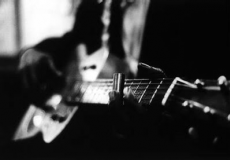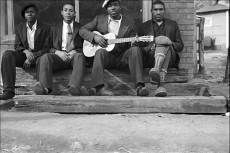
The Blues are a style of music that originally derived from African-American communities, situated in the South of America in the 19th century. The genre in itself is very much a fusion of many other genres such as Jazz, rock and roll, folk and more. The Blues once again regained popularity in the Great Depression in the 1930’s, as the economic crisis forced many people into poverty, and the Blues was frequently used as a means of expression.
Despite sharing aspects with other types of music, the Blues are in fact quite distinctive in many ways. A crucial part is the call and response; there are typically two phrases of music, and one instrument will play one, and another will ‘reply’ with another musical phrase which links with the first one. This technique is deeply rooted in African music.
There are several types of Blues scales that are frequently used too; for example, a hexatonic scale, containing six notes. These scales commonly feature lots of ‘flats’ and sometimes sharps, proving the song with a much more melancholy feel due to the minor key being used.
The standard chord progression is the twelve bar blues. Each line of the song uses four bars, however, the lead part, e.g the vocals, do not often fit cohesively with these bars, which is what gives the Blues such an interesting style. This chord structure usually incorporates around three chords, typically the first, fourth and fifth chords of a key.
The lyrics are generally narrative. In traditional Blues music, one line was repeated four times to compromise a verse. However, in the resurgence in the 20th century, the standard AAB pattern came around. This pattern involves of one line that is sung over the beginning four bars, it being repeated over the following four bars, and then a different and longer line over the final four bars of the progression.

In the Great Depression, this genre of music was adopted by a large part of the American population, especially those who experienced homelessness and were reduced to living on the streets or in crudely constructed shacks. The narrative nature of this music was perfect for people to use to express how their lives had been completely uprooted due to the financial crash.
Instruments used to play the Blues would be whatever people could get their hands on, or what they already had. As such, guitars, vocals and harmonicas were a standard. Although, other instruments like trumpets, saxophones, drums and piano were also used.
The Blues are not very prominent or well known within our current Western culture; not many artists produce Blues style albums, and many people have not listened to many of the ‘classic’ blues albums by artists such as Muddy Waters or B.B. King. One exception would be the popular actor and singer Hugh Laurie, having released two recent blues albums, featuring new compositions in the Blues style, alongside covers of reputed Blues pieces.
I believe that today, we should be giving Blues a bigger platform and more publicity, as they are not only a very accessible type of music due to the relatable and emotive lyrics, but because they are a very useful way to learn about history and the struggles people faced, as the music is almost entirely focused on human anguish. However, despite Blues not being a seemingly major part of our society’s music, we are lucky in the sense that so many genres feature important aspects of the wonderful Blues style, and as such, the power of the music will never be lost.
Image1: http://www.theproudarchivist.co.uk/event/the-fisherkings-live-blues-music/
Image2: http://johnedwinmason.typepad.com/john_edwin_mason_photogra/2010/05/review-hard-luck-blues.html

0 Comment:
Be the first one to comment on this article.